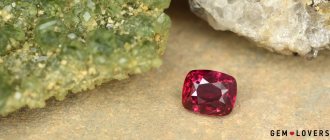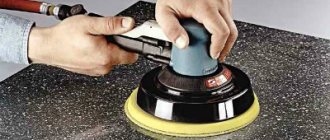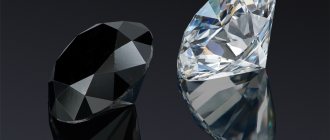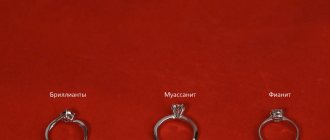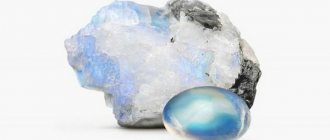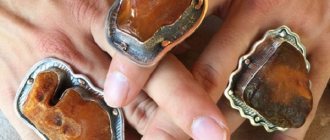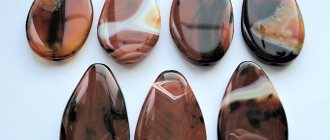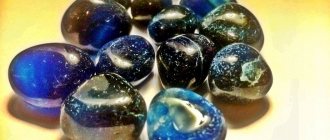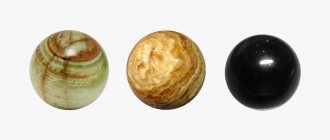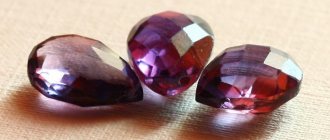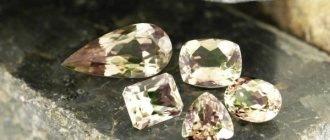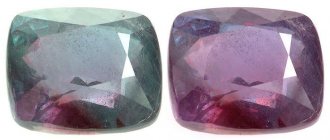Hello, dear readers! Do you already have malachite jewelry or are you just planning to buy it? In this case, you are probably wondering how to determine their authenticity. Malachite is a fantastic mineral; from ancient times to this day it has been shrouded in an aura of real magic. A talisman stone, a savior stone, a stone that connects with the secret world and opens a flow of abundance and prosperity for the owner. Of course, unscrupulous sellers often counterfeit such a wonderful mineral. From this article you will learn how to avoid becoming a victim of scammers - how to distinguish malachite from a fake.
Depletion of natural malachite deposits
Malachite initially could not be called a rare stone. However, the constant high demand for the gem led to the fact that numerous deposits were practically depleted, imitations poured into the market and the question of how to distinguish a fake from malachite began to arise more and more often.
At the moment, almost all places where stone is mined are concentrated in Africa, or more precisely in the Democratic Republic of the Congo (formerly Zaire), although previously it was actively mined in Russia, the CIS countries, and Western Europe.
In Soviet times, the Urals, Altai, and Kazakhstan were famous for their mining. But today the most famous mines of that time, in particular, in Nizhny Tagil (Mednorudyanskoye) and in Polevsky (Gumeshevskoye) are completely exhausted and do not function.
African malachite, which is the majority of the source of gem jewelry on the market today, has a number of notable features. Unlike stones previously mined in Russia, it has a larger, more regular and pronounced pattern of concentric rings. This reason, in particular, often causes problems in determining the authenticity of malachite among seasoned connoisseurs who are accustomed to the fact that a natural mineral should have an irregular, complex pattern.
Story
Malachite was not isolated as a separate mineral for a long time, considering it the result of chemical processes in copper.
The name is interpreted as meaning:
- mallow;
- soft;
- green grass.
Other names are peacock stone and health stone.
Archaeologists find ancient bronze artifacts with a malachite coating. A malachite pendant was discovered in Neolithic layers. Beads dating back 9 thousand years were found in excavated Jericho.
Russian mineral science took shape later than European science. Therefore, when European reserves were exhausted, they started talking about malachite from Russia, known as the Siberian stone. A French astronomer who conducted research in the Urals helped.
Variants of fakes of natural malachite
Counterfeiting natural malachite is not always an attempt to deceive. Due to the fact that stone jewelry always looks especially impressive and many people want to become the owner of an eccentric pendant or decorative item, imitation is still often just a need to satisfy demand and provide an opportunity to make a purchase on a limited budget.
In other words, in most cases the seller does not hide the fact that he is offering a fake, and the options for artificial products can be as follows:
- Malachite chips. The best option is, in fact, a very low-grade original. In this case, waste is used to create jewelry - small crumbs that are formed when making a product from a real large gem. The crumbs are glued together using epoxy resin and pressed in a special way. In fact, it is difficult to say unambiguously whether it is correct to call products made from crumbs fakes, since in this case the master still works with a real mineral, which has all the magical properties of the original, and, nevertheless, in the harsh rules of the jewelry world, such products are always in a controversial place.
- Synthetic gem. This is, in general, another controversial imitation. The synthetic gem is grown in laboratory conditions. It has the same chemical formula as a natural mineral and is indistinguishable in appearance, but since it is grown “in vitro”, it does not possess the magic of a natural stone.
- Imitation. In this case, we are talking about a clear counterfeit that has nothing to do with malachite. For counterfeiting, a stone of a different type is used; it is simply painted with a malachite pattern and coated with a protective varnish.
- Glass and plastic. They can paint not only another breed, but also glass or plastic. These are the lowest-grade fakes, which will not be difficult for anyone to distinguish, at least by weight. Glass and plastic feel completely different in your hands than stone.
All types of counterfeits of a natural product should cost less than the original. So a low price is one of the ways to distinguish malachite from a fake. However, problems begin when the seller is unscrupulous and tries to deceive - pass off the imitation as a natural gem and sell it for a high price.
Magic properties
There are many legends associated with malachite, some of which claim that it can make a person invisible, and that those who drink from a malachite cup understand the language of animals. In India, it is believed that malachite applied to the “third eye” chakra can cleanse the mind of grievances and anxieties. In Rus', malachite was considered a symbol of fulfillment of desires.
Physical properties of malachite
| Hardness: | 3.5-4 out of 10 on the Mohs scale |
| Shine: | glass, matte, silky |
| Transparency: | opaque |
| Color: | green, bright green, turquoise, dark green |
How to check malachite for authenticity
With careful inspection and a few simple experiments, determining the authenticity of a stone is not that difficult. Let's look at how to distinguish real malachite from a fake:
- Weight. First of all, we evaluate the weight. At this stage, the lowest-grade fakes - those made of plastic and glass - will be eliminated by themselves. It is worth noting that malachite is also heavier than many other stones, such as quartz, which is often used to create its imitation.
- Dullness. A real mineral is opaque, matte, its shine is barely noticeable, noble. If the mineral sparkles brightly with gloss or is transparent in light, it is certainly a fake.
- Heterogeneity. Despite the fact that the African rock, as we said above, has a regular pattern, no two identical stones exist in nature. This means that the answer to the question of how to check malachite for authenticity often lies in examining samples sold nearby. If they all look the same, you are looking at fakes; in the same case, when each gem is unique, most likely you are seeing originals.
- Shades. Heterogeneity should be expressed not only in the pattern, but also in color. When counterfeiting, the master, of course, uses several shades of paint, but, as a rule, no more than 3-4; nature creates a much more intricate play of color. It is noteworthy that they often try to pass off malachite as a coil. This is a natural breed, but less valuable. In order to identify these two minerals, you just need to carefully study the types of stones before purchasing. The obvious difference between malachite and serpentine is the shade of green; in the first case it is deep emerald, in the second it is closer to swamp.
- Test for ammonia and acids. If you have carried out an inspection, but still doubt the authenticity, and the seller insists on the naturalness of the stone, you can conduct two experiments, with the condition that if the mineral passes the test, you will definitely purchase it. These tests will slightly modify the stone, and therefore they should be carried out in an inconspicuous place, if we are talking about decoration - from its back. So, how to test malachite. The first test is to drop a drop of ammonia onto the mineral, wait a little, if this is the original, a section of the stone will turn pale and the drop itself will turn blue. The color change does not occur instantly, since natural gems are also coated with a protective varnish. The second test is acids. To make the acid, simply squeeze some lemon juice into a glass of warm water. Apply a drop of the solution to the gem; bubbles should appear on the surface, again, not immediately, if coated with varnish.
Please note that a synthetic mineral grown in a laboratory will withstand any test of authenticity. It is identical to natural in its chemical formula, physical properties and has a unique pattern. This means that there is no exact answer to the question of how to distinguish natural malachite from artificial malachite from the laboratory. In this case, the only guarantor of the authenticity of the stone is the integrity of the seller.
Well, now you know why the mineral is counterfeited today and how to distinguish malachite from an imitation. We really hope that the information provided will be helpful and useful to you. Don't forget to share it with your friends on social networks, perhaps they are planning to buy this beautiful stone right now.
Team LyubiKamni
Medicinal properties
The texts of Indian Ayurveda advise applying malachite to “blocked” areas of the body in order to “dissolve energy plugs” and open channels for the passage of bioenergy flows. Light colored malachites are considered the most useful. Placed on the solar plexus area, malachite relieves emotional stress. Malachite is able to absorb negative energy and create physical and emotional harmony in the human body. In modern lithotherapy, malachite is used for diseases of the heart, pancreas and spleen. It activates regeneration and has a positive effect on the pituitary and pineal glands. According to some American healers, malachite is a good anti-radiation agent.
Talismans and amulets
Malachite has value as a talisman and amulet in the following situations:
- It will make people who consider themselves unattractive more confident and instill hope.
- The mineral in combination with white metals is suitable for theatergoers.
- Readers, writers, and other masters of verbal creativity need a stone in a copper frame.
- Children's amulet - a newborn is given malachite, which is hung over the cradle to protect against dark forces. Keeps the child away from negativity, and helps children become taller if they are short.
- Leaders are the people for whom the mineral is suitable and necessary. A malachite device on the desktop will ward off ill-wishers and ensure a promotion at work or success in business.
- The malachite warrior will protect the owner, whose work involves risk.
- During serious illnesses, after surgery, wearing the stone reduces pain.
Malachite reveals magical properties for humans depending on the variety:
- radiant – attracts good luck;
- ribbon - healer;
- plush - has the meaning of a talisman on the road, travel;
- kidney-shaped and azure-malachite are a talisman for business.
The magical properties of the mineral are enhanced by a frame made of silver or copper, as well as by wearing one item. The kits will provoke unwanted energy resonance.
Areas of use
Information about the mineral was known back in Ancient Egypt and the Ancient World. Stones crushed into powder were used as cosmetics and paint for painting.
This is an element of the interior decor of palaces, public spaces, and housing of the nobility:
- mosaic panels;
- columns, countertops, mantelpieces;
- grandfather clocks, vases, sculptures.
The Hermitage is proud of the Malachite Hall with a collection of more than 200 objects. Green pre-altar columns decorate St. Isaac's Cathedral.
Today the importance of the malachite stone as a jewelry mineral is recognized. Its low cost made it in demand among stone carvers. Decorations, desk writing instruments, vases, and boxes are pleasing to the eye.
What is the price?
The price of processed malachite depends on the variety:
- turquoise - with noticeable blue and contrasting stains, used as jewelry;
- plush - with a matte sheen and a texture reminiscent of branches, an ornamental material.
How much a stone costs is influenced by its purity, presence of inclusions, and location of extraction. The Ural mines were previously considered valuable, but they are depleted, there is no industrial production, so now Africa is in the lead. Roads are natural clean stones from the USA and Australia.
The cost of untreated stone is low - the price per kilogram of the turquoise variety is $20–30.
The price for malachite is set per gram in exceptional cases. Jewelers evaluate a stone, product or decoration. A tumbler from the Congo up to 3 cm costs up to 700 rubles, a bracelet up to 20 cm long – 1500–2500 rubles, a keychain 2x3x1 cm – 300–500 rubles, a box made of Zairean malachite weighing 410 grams (7x10x4 cm) – 13 thousand rubles. .
Colors and types
The main color of malachite is green, the range of colors is from light to thick green. The characteristics of malachite stone include a description by type:
- pure – flawless green;
- spotted - with black spots;
- multi-colored - a combination of green with azure or blue;
- patterned - light green circles or lines on a darker background.
A blue-green tint indicates the presence of impurities (usually azurite or chrysocolla).
According to the characteristics, the description of malachite is as follows:
- turquoise is a light green-blue stone, the densest, therefore it is well processed and polished;
- velvet or plush - increased grain size and particles resembling velvet make processing difficult;
- finely patterned or curly - a rare beautiful variety of the mineral, described in the tale of P.P. Bazhov "Malachite Box".
It is believed that the more intricate the surface, the magically stronger the stone.
The mineral malachite is distinguished by its luster:
- matte;
- velvety;
- silky, iridescent.
Single-color stones are rare; they are almost always chaotically arranged layers.
Product care
The hardness of malachite is below average, so anyone who wants to have it must provide special care:
- Protect the stone from impacts and other mechanical influences.
- Avoid temperature changes.
- Avoid interaction with household chemicals, acids, and abrasives.
- Clean only with mild detergents, wash in soapy water.
- Store the mineral in a natural fabric bag or box separately from other, more durable gemstones to avoid scratching.
Malachite protects the owner from negativity, absorbing it into itself, therefore it needs recharging and energy purification. To do this, the pebble is buried in the ground for a couple of days or exposed to the sun in a quartz druse. If stones are used as healing, such procedures are carried out after each session.
